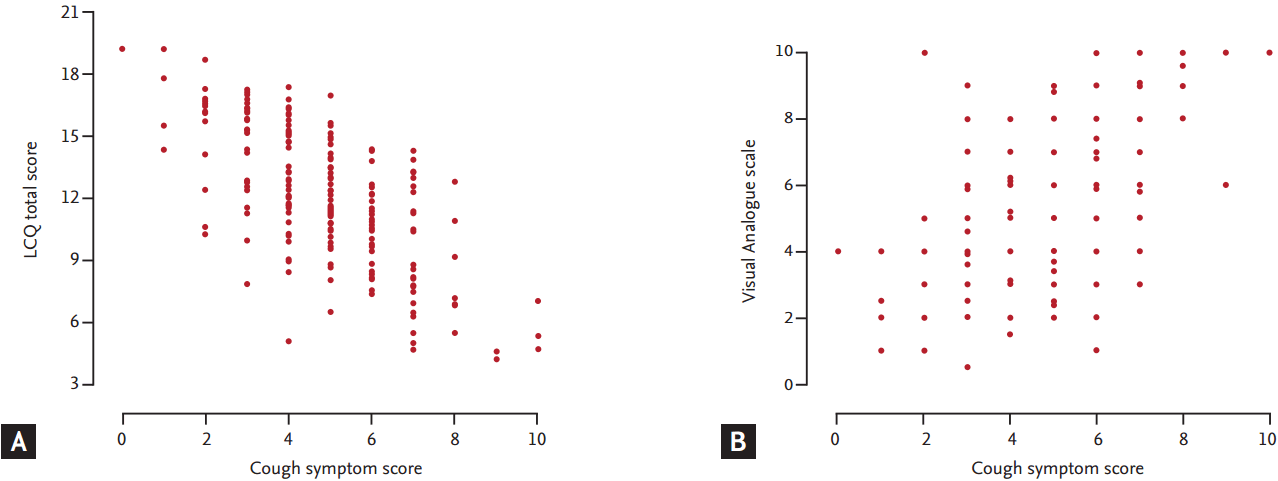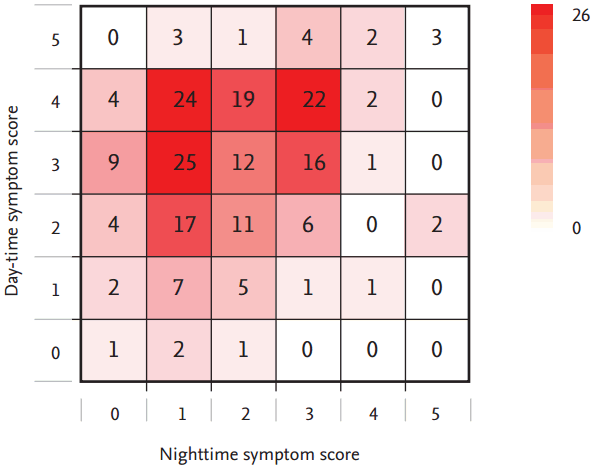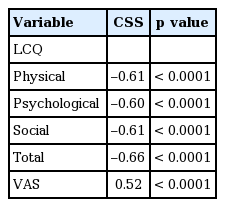Korean version of the Cough Symptom Score: clinical utility and validity for chronic cough
Article information
Abstract
Background/Aims
The Cough Symptom Score (CSS) is a simple, useful tool for measuring cough severity. However, there is no standard Korean version of the CSS. We developed a Korean version of the CSS and evaluated its clinical utility and validity for assessing chronic cough severity.
Methods
The CSS was adapted for Korean use following a forward-backward translation procedure. Patients with chronic cough enrolled from five university hospitals were graded using the CSS and a 100-mm linear visual analog scale (VAS) of cough severity at each visit. Patients completed the Leicester Cough Questionnaire (LCQ) upon presentation and completed the LCQ and Global Rating of Change at follow-up visits after 2 to 4 weeks. The concurrent validity, repeatability, and responsiveness of the Korean version of the CSS were determined.
Results
Correlation coefficients between the CSS and LCQ, and between the CSS and VAS, were –0.66 and 0.52, respectively. There was a weak correlation between the scores for night and day symptoms (r = 0.24, p = 0.0006). The repeatability of the CSS in patients with no change in cough (n = 23) was high (intra-class correlation coefficient, 0.75; 95% confidence interval [CI], 0.51 to 0.88). Patients who reported an improvement in cough (n = 30) at follow-up visits had a significant improvement in the CSS (median, –2; 95% CI, –3 to –1; p = 0.0003).
Conclusions
The Korean version of the CSS correlated well with other tools for accessing cough severity in chronic cough patients. Therefore, it could be a reliable method for measuring chronic cough severity.
INTRODUCTION
Cough is a common problem for which medical attention is sought. A way to assess cough severity or the effectiveness of cough management is needed, especially for chronic cough, defined as a cough lasting more than 8 weeks [1,2]. Outcomes often measured to assess cough include one or more of the following: cough severity, cough impact on quality of life, cough frequency, or cough sensitivity. However, these assessments are not based on standardized or valid measures [3]. Because there is limited and insufficient evidence of the reliability or concurrent validity of the different types of cough diaries and visual analog scale (VAS) scores, the American College of Chest Physicians guidelines suggested that cough-specific questionnaires, a VAS, or numeric rating scales should be used in a standard fashion [3-5]. The Cough Symptom Score (CSS) consists of two questions about the subjective recognition of cough frequency in the day and at night. The CSS is a subjective, self-completed questionnaire used to measure cough that has been used widely in many studies of cough [6-10]. It is simple and short, and seems to be more practical than cough-specific quality-of-life questionnaires in clinical practice. However, the CSS has not been validated for use among the Korean population.
This study developed a Korean version of the CSS and compared its relationship with clinical parameters, as well as VAS or Leicester Cough Questionnaire (LCQ) scores, to determine its reliability, validity, and responsiveness for assessing chronic cough [7,11-13].
METHODS
Subjects
We enrolled patients with chronic cough from five university hospitals (Hanyang University Guri Hospital, Samsung Medical Center, Seoul National University Hospital, Seoul National University Bundang Hospital, and Kangwon National University Hospital) between May 2011 and October 2013 [13]. Chronic cough was defined as a cough lasting for more than 8 weeks. Patients aged < 15 or ≥ 70 years were excluded. Patients were graded using the CSS, LCQ, and a 100-mm linear VAS of cough severity (ranging from “no cough” to “worst cough”) at enrollment and follow-up visits after 2 to 4 weeks. The Global Rating of Change (GRC) was completed only at the follow-up visits after 2 to 4 weeks. The study protocol was approved by the Institutional Review Board of each participating hospital, and informed consent was obtained from all patients.
Cough Symptom Score
The CSS, which was proposed by Hsu et al. [8], and consists of two questions regarding subjective cough severity during the day and in the evening, has been used widely in many studies to assess cough frequency and severity, since there are no standard objective methods to measure cough frequency [8-10]. The scores for each question range from 0 to 5, and so the CSS total score ranges from 0 (no cough at all) to 10 (most severe cough). The CSS was adapted for Korean populations following a forward-backward translation procedure, with independent translations and counter-translations. The suitability of the wording and phrasing of the Korean version of the CSS was tested in three patients with coughs.
Leicester Cough Questionnaire
The LCQ is a cough-specific quality-of-life questionnaire containing 19 items that are divided into physical, psychological, and social domains [13]. A 7-point Likert scale is used to evaluate responses to each item, and the domain scores range from 1 to 7. The total score ranges from 3 to 21; a higher score indicates a better quality of life.
Global Rating of Change
The GRC assessment was performed to evaluate self-perceived changes in disease status since the first visit. Scores range from 7 (a great deal better) to –7 (a great deal worse) and status is classified as unchanged (–1, 0, 1), small change (–3, –2, 2, 3), moderate change (–5, –4, 5, 4), and large change (–7, –6, 7, 6) [14]. Scores of 4, 5, 6, and 7 are considered to represent a clinically significant improvement [15].
Validation
Concurrent validity indexes the validity of an instrument against other standards; this was assessed by correlating the CSS with LCQ and VAS scores. A correlation coefficient ≥ 0.4 is generally regarded as a moderate correlation, while correlations > 0.75 are considered as strong correlations. The relationship between the two questions regarding subjective cough severity, both during the day and in the evening, was assessed for internal consistency using Spearman correlation coefficient. The repeatability of the CSS was assessed in patients indicating no change (–1, 0, 1) in the GRC at follow-up visits over 2 to 4 weeks. Assuming no difference in the average score between the test and retest, and that the standard deviation of the total score was identical at each time point, 14 patients were required with 0.75 as the lower limit for high agreement with a 95% confidence interval (CI), in the expectation of a 0.9 intra-class correlation coefficient (ICC) [16]. An ICC ≥ 0.4 is generally regarded as a moderate correlation and an ICC > 0.75 denotes a strong correlation. The responsiveness of the CSS was assessed in those patients indicating clinical improvements (4, 5, 6, and 7) in the GRC upon follow-up visits after 2 to 4 weeks.
Statistical analysis
Patient characteristics are presented as mean ± SD for continuous variables and as relative frequencies for categorical variables. Each symptom score during the day and at night are shown as mean ± SD are scores are compared using the Wilcoxon signed-rank test. Spearman correlation coefficients between the CSS and LCQ scores were calculated to assess concurrent validity, since the CSS and two of the three LCQ domains did not follow a normal distribution. Internal consistency was evaluated using Spearman correlation coefficient between the two questions in the CSS. Repeatability was assessed by calculating the ICCs. Responsiveness was assessed using the Wilcoxon signed-rank test to compare CSS at baseline and after clinical improvement, since the CSS data did not follow a normal distribution. The statistical analysis was performed using SAS software version 9.3 (SAS Institute, Cary, NC, USA).
RESULTS
The study enrolled 207 patients with chronic cough and their characteristics are shown in Table 1 [13].
The correlation coefficients of concurrent validity, determined in 202 patients, are shown in Table 2. The correlation coefficients between the CSS and LCQ ranged between –0.66 and –0.60. The CSS was also well correlated with VAS scores (r = 0.52, p < 0.0001) (Fig. 1). The scores for daytime symptoms were more closely related to LCQ quality of social life than were the scores for nighttime symptoms (r = –0.543, p < 0.0001 vs. r = –0.441, p < 0.0001). The scores for nighttime symptoms were more closely related to LCQ physical and psychological quality of life than were the scores of daytime symptoms (r = –0.557, p < 0.0001 vs. r = –0.416, p < 0.0001; r = –0.481, p < 0.0001 vs. r = –0.470, p < 0.0001, respectively).

Relationship between the Cough Symptom Score (CSS) and (A) Leicester Cough Questionnaire (LCQ) scores and (B) visual analog scale.
The internal consistency of the CSS (n = 207), given by Spearman correlation coefficient between the night and daytime symptom scores, was 0.24 (p = 0.0006) (Fig. 2). Symptom scores during the day were higher than those during the night (3.06 ± 1.13 vs. 1.80 ± 1.14, p < 0.0001).

Distribution of daytime and nighttime Cough Symptom Score cough frequency scores. The color and number in each square indicate the number of patients. Spearman correlation coefficient between nighttime and daytime symptom scores was 0.24 (p = 0.0006).
The repeatability of the CSS in patients with no change in cough status (n = 23) was high (ICC, 0.75; 95% CI, 0.51 to 0.88). Patients who reported an improvement in cough (n = 30) at follow-up also had a significant improvement in the CSS (Table 3).
DISCUSSION
The Korean version of the CSS correlated well with patients’ perceptions, as shown by VAS and cough-specific quality-of-life questionnaire scores. The Korean version of the CSS appears to have acceptable repeatability and responsiveness to change.
Evaluating the severity of chronic cough is important for both research and clinical practice, because the accuracy of the diagnosis is given by the response to specific treatment in most cases [11]. However, evaluation of cough using validated methods remains challenging for both clinicians and researchers [6]. To evaluate the efficacy of cough-modifying agents optimally, investigators are recommended to use both subjective and objective method because they have the potential to measure different things [7]. Therefore, cough-specific quality-of-life questionnaires, such as the LCQ, are usually recommended for assessing cough severity [6,10], because these questionnaires have been widely used, show repeatability and responsiveness, and correlate with cough frequency in chronic cough [9-13,17]. However cough-specific quality-of-life questionnaires take a relatively long time to complete and their use is not convenient in daily practice. Although a VAS is very convenient and easy to use, the correlations between VAS and objective cough measurements or quality-of-life scores are inconsistent [6]. In comparison, the CSS is a simple tool for scoring subjectively experienced cough frequency and there are several different forms of the instrument [7,8,16,18]. And thus, a standard Korean version of the CSS is needed. Several studies have shown moderate correlations between objective cough frequency and CSS [8-10], but no studies have examined the correlations between CSS and LCQ or VAS scores.
The demographic characteristics of the study population were similar to those in a previous report on Korean patients with chronic cough, in which middle-aged women were predominant [19]. There were differences in the subjective cough frequency between daytime and nighttime in this study, although there was a weak correlation. This suggests that there are diurnal changes in cough severity in many patients with chronic cough. This is consistent with the results of several previous reports on patients with chronic cough, which showed that the daytime CSS was higher than nighttime scores, and cough frequency indexed by objective cough monitoring was also higher during the daytime [9,10]. Using an objective cough measurement, Marsden et al. [10] showed that coughing rates during the day and at night were different in asthmatic patients and showed a moderate correlation. In addition, the current study showed that nighttime subjective cough frequency was related more to the psychological aspects of quality of life, while the daytime subjective cough frequency was related more to the social aspects of quality of life.
In conclusion, we developed a Korean version of the CSS, which correlated well with VAS and LCQ scores in patients with chronic cough. This study suggests that the Korean version of the CSS could be used to evaluate the results of interventions for the management of chronic cough, and is a useful parameter for evaluating chronic cough in the clinic and for research purposes.
KEY MESSAGE
1. We developed a Korean version of the Cough Symptom Score (CCS) and examined its clinical utility.
2. The Korean version of the CSS correlated well with scores on a cough-specific quality-of-life questionnaire and a visual analog scale used to access chronic cough severity.
3. The Korean version of the CSS showed acceptable repeatability and responsiveness to change in patients with chronic cough.
Notes
No potential conflict of interest relevant to this article was reported.


